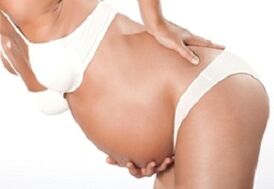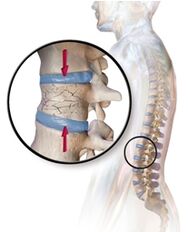Periodic or persistent back pain affects approximately 80% of the world's population. The problem occurs more often in women. The symptom is called lumbodynia. It is so common due to the constant high stress on the lumbar spine. He feels pressure from 50 kg (supine) to 220 kg if the person is sitting sprawled. The problem indicates a lifestyle injury or a serious illness. With age, it worsens and can lead to patient disability.

Physiological causes of pain
Discomfort in the form of pain is the body's defensive reaction. It then reacts to various "abnormal" processes within, which doctors call pathologies. The body hurts in an awkward position and after physical exertion, telling the brain that it is difficult for it to complete tasks.
An uncomfortable position
Lower back pain accompanies prolonged discomfort. The problem worries drivers and employees, as they spend a lot of time sitting, when the lower back is exposed to maximum stress. A person has back pain from fatigue. If he does something for a long time in a bent position.
The back hurts after sleeping if the sleeping place is poorly equipped. For example, the bed surface is too hard or soft to provide adequate spine support and quality muscle relaxation.
Loads increased
Muscles and ligaments can hurt your back. They support the spine in a stable position and undergo stress with intense physical exertion. The conditions for the onset of pain arise with sudden movements, accompanied by muscle tension in the lumbar region. This happens if a person carries weights, pulls heavy objects, lifts them up and down (folding "in half").
Muscles can also get tired during sports. If a person exercises a lot, his ligaments need time to recover. If there is no good rest, they wear out or become inflamed, which is signaled by the nervous system with pain.
Back pain of women Women
The problem of lower back pain is very common among women, as the beautiful half of humanity regularly experiences them under certain conditions. Menstrual abdominal pain is often accompanied by discomfort in the lower back and sacral region. This is not associated with increased stress, but is a consequence of the production of prostaglandins (pain mediators). Before and during menstruation, the synthesis of mediators triggers hormonal changes in the female body.
in the female body.
The lower back of girls hurts when carrying a baby (in 95% of pregnant women). Not only does the spine experience great stress outside of pregnancy. The pressure on the lower back increases many times as the woman's weight increases. Additional loads are created by the pregnant belly. She pulls the expectant mother's body forward, changing the axial load distribution. As a result, the woman's gait changes, low back pain occurs, the intensity of which increases according to the duration of pregnancy. Loads increase in any position of the expectant mother, so a good rest, lying on a quality mattress is extremely important in alleviating the condition of the woman.
hypodynamia
Discomfort often occurs in people who do not play sports or lift heavy objects. The reason for this is the weakening of the muscular system. The back muscles need to be strong to adequately support the spine and relieve stress from it. If this does not happen, the bone and cartilage tissue wears out faster, which is accompanied by pain.
Structural anomalies
The spine is made up of a skeleton of bone: the vertebrae. Between them are soft "layers" of cartilage tissue - vertebral discs. Vertebrae provide strength and stability, cartilage - flexibility and elasticity of the spine. The main structural elements are hollow in the center. The canal is filled with the spinal cord. All components are surrounded by blood vessels, nerve fibers. Pathologies in any element of the lumbar spine cause lombosis.
Osteochondrosis
The disease develops when the discs of the intervertebral cartilage wear out. Due to heavy loads, the lumbar discs are damaged very often. The most common causes of severe lower back pain are protrusion (subsidence) and hernias (damage and protrusion of the contents) of the discs, in which the nerve roots of the spine are pinched. Osteochondrosis affects people over the age of 35. The disease is particularly common in the elderly.
Trauma
The lumbar spine is considered the strongest because it constitutes the main "axis" for the entire human body. However, with sudden falls and movements, the vertebrae of this section are more often injured. Most fractures and bruises of the spine are located right in the lower back.
Vascular damage
The vessels provide nourishment to all the tissues of the spinal column. If their lumen narrows or overlaps, the trophic processes in the spine radically worsen. As a result, inflammation occurs, which always manifests itself in pain.
Nerve entrapment
Nerve fibers can be damaged due to possible damage to the cartilage and vertebrae, in case of infectious diseases. Any pathology of the nerves is accompanied by abrupt recovery and sometimes unbearable back pain.

Bone disorders
Osteoporosis leads to calcium leaching and bone fragility. If the spinal tissue is depleted, the risk of serious back injury increases. Additionally, osteoporosis can change the shape of the bones in the spine and increase pressure on the nerve roots.
Another cause of pain is vertebrae tumors. The most common type are hemangiomas. These benign neoplasms develop asymptomatically for a long time, but when the tumor becomes too large and extends beyond the vertebra, the patient experiences severe pain.
Inflammatory processes
Arthritis can affect any joint in the body. Inflammation leads to joint damage and pain. It can be caused by advanced and chronic infectious diseases. Another cause of arthritis is autoimmune damage to the connective tissue.
Internal problems
The lower back can hurt not only due to pathologies of the spine. Painful sensations associated with pathologies of internal organs or with some systemic diseases can be given to the lumbar region.
Internal organs
Back pain is associated with kidney damage. Renal colic is accompanied by sharp and sharp pain on one or both sides of the back. Most often it is felt just below the ribs in the back of the body.
Lumbar discomfort often occurs against the background of intestinal diseases, with inflammation of the pelvic organs (bladder, prostate - in men, ovaries and uterus - in women).
Systemic pathologies
Psoriasis and ankylosing spondylitis cause lower back pain. With these diseases, violations in the structure of the connective tissue (cartilage) occur. It loses its elasticity and therefore often becomes inflamed. Over time, significant disturbances occur in the functioning of the joints, and the nerve endings are under persistent (impaired) compression. With ankylosing spondylitis, the intervertebral spaces "harden".
Lower back pain can cause shingles. Rashes with this disease appear on the shoulder blades, ribs, but more often - on the lateral surfaces of the trunk in the lumbar region. The first pains appear before significant changes in the skin. When a rash appears, the discomfort intensifies, complemented by itching. Even after the spots have completely disappeared, a person still has severe pain along the inflamed nerves. They can bother the patient for several months.
tumors
Malignant lesions of the spinal cord and bones do not initially change the patient's condition. As the tumor grows and atypical cells spread in the structure of organs and tissues, changes occur in which nerves are affected. This is manifested by severe pain. Discomfort in the lower back is felt not only with injuries of the lumbar spine, but also if the tumor grows in the internal organs, which are innervated by the nerve ganglia of this department.
Nervous disorders
Back pain can be phantom (in other words, invented by the patient himself). This happens with psychoneurotic disorders. The psyche does not function properly against the background of shock, stress, prolonged psycho-emotional stress. Discomfort can arise if a person instills himself with the disease, suffers from overwork. These signs first appear after depression or a nervous breakdown and can bother the patient for many years.
How to get rid of lower back pain
If unpleasant sensations occur in the lower back, the patient must rest completely, reduce the intensity of the load. As a rule, after a good rest, the discomfort subsides or disappears altogether. This is a typical symptom of pain caused by improper lifestyle, poor quality rest. If the pain persists, you need to think about a visit to the doctor.
The nature of back pain is diagnosed by traumatologists, vertebrologists, orthopedists. You can contact one of the listed specialists. At the first consultation, the doctor will interview the patient, examine him, carry out several tests (check the sensitivity of the nerves, the condition of the muscles). If a diagnosis cannot be made based on the information received, an additional examination will be scheduled. To assess the condition of the bone tissue, an x-ray is prescribed. The structure of cartilage, nerves, the condition of blood vessels and the spinal cord can be assessed by magnetic resonance imaging. If the doctor suspects a systemic disease, the patient is prescribed laboratory diagnostics (general and biochemical blood and urine tests). Only after making the correct diagnosis, the specialist will prescribe treatment.
Pharmacological therapy
The list of drugs depends entirely on the diagnosis. To quickly eliminate the symptoms, the patient will be prescribed a short course of painkillers (usually from the group of NSAIDs). With strong inflammatory and autoimmune changes, glucocorticoid drugs are prescribed. For diseases of the cartilage tissue, chondroprotectors are recommended in injections or tablets. If the problem is with the muscles, muscle relaxants are recommended. To restore the work of nerve endings, vitamins of group B.
The main treatment is directed at the cause of the pain. If it is caused by diseases of the internal organs, drug therapy will correct disorders in the functioning of the kidneys, gastrointestinal tract and genitals. Symptoms will disappear with the elimination of the underlying disease. With unbearable pain, a nerve block is performed (analgesics are injected directly into the nerve root areas).
To enhance the action of injections or tablets, external painkillers (patches, ointments, gels) may be prescribed. Such drugs can be used independently, with recurrent lower back pain against a background of tension or increased stress. To relieve the condition, you can use a pepper or menthol patch. They can also be used without a prescription.
Procedures
For low back pain, a specialist may recommend special treatments. These include acupuncture, physiotherapy with electric currents, ultrasound, therapeutic ultraviolet rays. In some cases, physiotherapy exercises and massages are indicated. If the vertebrae are displaced, you may need the help of a chiropractor to put the bone back in place. Any procedures should be selected together with a doctor. It is forbidden to undergo treatments in which they act directly on the spine, without diagnosing the disease. In this case, the procedures may not only be useless, but also harm the patient.
To prevent back pain, it is necessary to monitor the health of the spine from a young age. It is important to properly exercise loads on the back (to lift crouched objects and not to bend over, push heavy objects and not pull them towards you). You should engage in moderate physical activity and select exercises with a trainer. It is also important to treat infectious diseases in a timely manner, avoid stress, take any medications reasonably and as prescribed by a doctor.













































